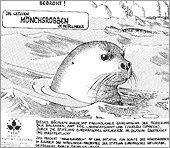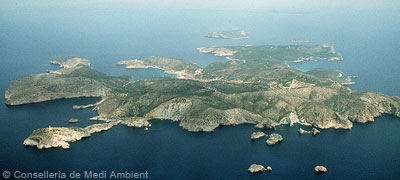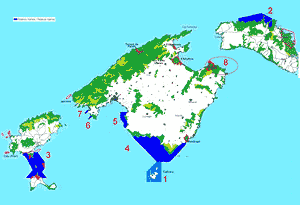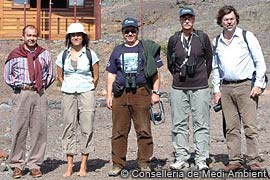

 |
||
 |
||
Vol. 9 (1): June 2006 |
||
The Government of the Balearic Islands,
|
||||||||||||||
 |
 |
 |
|
The texts and drawings of this educational cartoon series, created in the Balearics, have been shared with the European Natural Heritage Fund (to be translated into German), with the Parc National de Port Cros (French) and the Institut Scientifique des Pêches Maritimes of Morocco (Arabic). |
||
In addition to these specific initiatives, there is also good news regarding protection of Balearic coastal marine habitat, a vital component of any future efforts toward monk seal reintroduction. Various initiatives from both the environment and fisheries departments of the Spanish state, as well as the Balearic Islands government have produced a wide range of marine protected areas (MPAs). Cabrera National Park, Ses Salines Natural Park and an integrated network of marine reserves[3] that are oriented toward sustainable management of fisheries now cover more than 52000 ha, and in the coming months a new marine reserve of 30000 ha will be declared. When this occurs, all three of the areas identified in the feasibility study (cited above) as suitable for the monk seal reintroduction will have effective management structures in place. This will include patrol boats and wardens for the enforcement of restrictions on intensive fishing practices, implemented after consultation and agreement with both the recreational and professional fishermen.
 |
|
Southern coast of Cabrera archipelago National Park, one of the Balearic Islands’ protected areas where appropriate fisheries and boating management and staff structures are in place. |
Except in the specific ‘no take’ sanctuaries, these areas are not totally forbidden to fishing but are subject to complex and detailed regulations; intensive fishing techniques are not permitted and a new fisheries management culture has been established, open to public participation through a consultative board, where management objectives are revised thanks to scientific studies carried out in the reserves. That framework can hopefully make things easier when the time comes for reviewing the management parameters in the reserves, in order to achieve the necessary conditions for a harmonic cohabitation between humans and monk seals.
 |
|
|
8 MPAs (1 National Park, 1 Natural Park and 6 Marine reserves) have been established or declared all around the coast of the Balearic Islands. 1 Parc Nacional de Cabrera; 2 Reserva Nord de Menorca; 3 Els Freus d'Eivissa; 4 Migjorn de Mallorca; 5 Badia de Palma; 6 El Toro; 7 Malgrats; 8 Peninsula de Llevant (to be declared soon). [larger map] |
The creation of new coastal MPAs as tools for conservation purposes and/or sustainable fisheries management in the Mediterranean is a growing trend that will ultimately make it difficult – fortunately – to keep track of the growing surface that is protected by all the existing and approved initiatives. As a result, we dare say that the Balearic Islands is leading this process in Spain and probably in the western Mediterranean as a whole. We will soon account for more than 50% of the total Spanish marine protected surface reported in 2004.[4]
Monk seals are back on the Balearic Islands conservation agenda because the local government environment minister has become interested in pursuing the restoration of local populations, even if the steps and timeframe have yet to be established. This has resulted in the establishment of a working group mandated to draft a document blueprint to provide a basis for future projects. To facilitate this effort, a poll has been conducted among relevant resource specialists in our area. Recently the people responsible for the monk seal initiative visited the Desertas Islands Nature Reserve, to learn firsthand how a successful monk seal recovery project is being conducted in the Madeira archipelago. As a result, new contacts and exchanges are planned, based on the recognition that monk seal recovery will require the active collaboration of each and every stakeholder, and that the flow of knowledge between all participants benefits everyone.
At present, we have an initial “roadmap” structured around three initiatives:
First, our sincere offer to contribute to ongoing conservation initiatives for monk seals, wherever they occur. The Balearic Islands Government will offer cooperation on projects that aim to conserve and improve the status of local populations, as well as those designed to expand our knowledge and management experience in the locations where monk seals still exist. These projects should always be framed within the existing international plans for protection and recovery of Mediterranean and Atlantic monk seal populations. A modest sponsorship contribution towards The Monachus Guardian and producing a Spanish language translation during 2006 (and hopefully in the coming years) shows our interest in keeping the best channel of communication open, loud and clear, among all the international community. We also believe that this fully conforms with the spirit of the recently approved ‘Portoroz Declaration’[5].
Secondly, we will work hard to change the perception in our society that the monk seal is a long and forever gone part of the archipelago’s fauna. Widespread public information and environmental education programmes will increase the awareness of local people. By highlighting the causes of the local extinction, and providing details of what’s needed to improve the habitat to make it suitable for the monk seal, we hope to forge the conviction that monk seals are an intertwined part of our Mediterranean natural heritage that we can’t allow to be lost. To do so, an agreement has been reached with the Fundació Territori i Paisatge[6] to jointly develop a travelling educational exhibition to promote public awareness about monk seal issues. The elements developed for that exhibition will be offered to the wider international community to be translated and adapted lo local realities.
Finally, we are keeping our efforts focused on strengthening and completing existing plans (and where possible, writing new ones) for coastal MPAs and marine ZECs[7] that were established by the Natura 2000 system in our archipelago.
None of these initiatives include, in the short or medium term, the capture or translocation of monk seal individuals.
 |
|
|
Rosa Pires of the Parque Natural da Madeira (second from left), kindly shared with us details of the successful monk seal recovery programme in the Desertas Islands. |
In the mid- and long term, our main goal is to ensure that the Balearics habitat and management structure are prepared to receive reintroduced monk seals as soon as it is beneficial for the maintenance and recovery of existing populations. In other words, we want to recover the Balearics for the monk seal and be ready when monk seals are recovered and ready for the Balearics. This is not a superficial local approach of having nice flowers and a few fish in our backyard. We are actively setting up the necessary conditions in the local marine habitat where a viable population can begin to recover in a strategic Western Mediterranean location that is central to the two main remaining populations. Fortunately, several pinniped species around the world, including the Hawaiian monk seal, have shown that it is possible for marine mammals to coexist with modern human societies. We believe that harmonic cohabitation of humans and Mediterranean monk seals is possible if we carefully prepare both species to exist together. The key condition is social acceptance of the species, that will avoid the direct killing of seals – the decisive factor in their local extinction throughout their historical range.
Though we face undeniable problems in achieving this goal, the determination to resolve them is a road that must be explored. Only time will give us the final answer, but the tenacity of both humans and seals will have a key influence!
1 email: jmayol(at)dgcapea.caib.es
2 The study, made by Manu Sanfelix in 1998, divided in 3 parts, can be downloaded from the Balearic islands government website:
http://dgcapea.caib.es/pe/documents_pe/public_pe/tecnics/foca01.pdf
http://dgcapea.caib.es/pe/documents_pe/public_pe/tecnics/foca02.pdf
http://dgcapea.caib.es/pe/documents_pe/public_pe/tecnics/foca03.pdf
3 http://dgpesca.caib.es/user/reserva/reservas.es.htm
4 http://www.faocopemed.org/en/activ/research/mpas.htm#part5
ftp://ftp.fao.org/docrep/fao/007/ae360s/ae360s00.pdf
5 http://www.rac-spa.org/telechargement/Divers/Portoroz%20declaration.pdf
6 http://obrasocial.caixacatalunya.es/osocial/main.html?idioma=3
7 Special areas of conservation as defined in the Council Directive 92/43/EEC of 21 May 1992 on the conservation of natural habitats and of wild fauna and flora
http://eur-lex.europa.eu/LexUriServ/LexUriServ.do?uri=CELEX:31992L0043:EN:HTML
Copyright © 2006 Joan Mayol, The Monachus Guardian. All Rights Reserved |